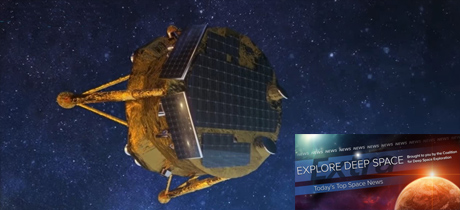In Today’s Deep Space Extra… The National Space Foundation unveils humanity’s first image of a black hole on Wednesday, the result of a decade-long effort to see what was previously believed to be unseeable. Lockheed Martin offers a plan for returning to the surface of the Moon with human explorers in 2024 at this week’s Space Symposium in Colorado Springs. The National Space Foundation unveils the first image of a black hole on Wednesday. Israel’s Beresheet lander will attempt to touchdown on the Moon’s Sea of Serenity Thursday afternoon.
Human Space Exploration
Lockheed Martin: Here’s how the U.S. can put humans on the moon’s surface by 2024
Coalition Members in the News – Lockheed Martin, Boeing
Houston Chronicle (4/11): Lockheed Martin, the prime contractor for NASA’s Orion crew capsule, offered a plan this week to return to the lunar surface with human explorers by 2024. The strategy, presented at the annual Space Symposium in Colorado Springs, would send the third Orion capsule with four astronauts to a lunar orbiting Gateway. There a lander and ascent vehicle would descend with astronauts. Work on the lander would have to begin by next year with sufficient resources, according to Lockheed, which would plan to work with other commercial partners to prepare for the mission.
Returning to the Moon in 5 years is within reach
The Hill (4/10): In an op-ed, Sean O’Keefe, who served as NASA’s administrator from 2001 to 2005, explains why the U.S. can return to the Moon with human explorers by 2024, a goal set forth in late March by Vice President Mike Pence, who chairs the White House National Space Council. It’s a realistic goal, one that has been achieved before, writes O’Keefe, now a professor of public administration at Syracuse University.
Space Science
An extraordinary image of the black hole at a galaxy’s heart
The Atlantic (4/10): The National Science Foundation, with partners from around the world, unveiled the first ever image of a super massive black hole, showing the event horizon. The image came from an arrangement a decade in the making to combine the capabilities of radio telescopes on multiple continents in April 2017. The findings offer supporting evidence for Einstein’s century old theory of general relativity.
Darkness visible, finally: Astronomers capture first ever image of a black hole
New York Times (4/10): The image features a dark coin like center with a glowing border some 55 million light years from Earth. It was unveiled Wednesday by the National Science Foundation as the first image of a super massive black hole, Messier 87. “We have seen what we thought was unseeable,” said Shep Doeleman, an astronomer at the Harvard-Smithsonian Center for Astrophysics and director of a decade long, worldwide effort to capture the image.
Israeli Moon landing to mark milestone in lunar exploration
Axios.com (4/10): Israel IL’s privately backed Beresheet lander could join an elite circle Thursday as it attempts to soft land at the Moon’s Sea of Serenity. Beresheet was launched February 21 as a secondary payload on a SpaceX Falcon rocket and entered lunar orbit on April 4. Only the U.S., Russia and China have accomplished as much.
Largest dust storm on Mars ever recorded may reveal why it’s so dry
New Scientist (4/10): Last year’s global dust storm on Mars, the one blamed for the demise of NASA’s long lived Opportunity rover, appears to have revealed some of the atmospheric processes that move clouds of water ice and vapor as well as dust around the Red Planet. The observations were made with the European Space Agency’s (ESA) ExoMars Trace Gas Orbiter.
First results from the ExoMars Trace Gas Orbiter
ESA.int (4/10): New evidence of the impact of the recent planet-encompassing dust storm on water in the atmosphere, and a surprising lack of methane, are among the scientific highlights of the ExoMars Trace Gas Orbiter’s first year in orbit.
Other News
Space investment hits record high in 2018
SpaceNews.com (4/10): Investment into space companies hit a record high in 2018, exceeding $3 billion with no sign of an imminent downturn, according to a new report by a consulting firm.
NASA invests in potentially revolutionary tech concepts
NASA Jet Propulsion Laboratory (4/10): NASA’s Innovative Advanced Concepts program Wednesday announced investments in 18 advanced concepts programs to hasten deep space exploration. The tech advances include human space suits and strategies for mining ice locked the shaded recesses of craters at the Moon’s poles. Each of the phase one awards is valued at $125,000.
Space launch startup Rocket Lab is building satellites now, too
Space.com (4/9): Launch services startup Rocket Lab has announced plans to also begin small satellite production for its Electron launch vehicles. The small satellites will be known as Photons. CEO Peter Beck, speaking at the Space Symposium under way this week in Colorado Springs, said the company’s turnkey approach will remove barriers to commercial space.
Space Development Agency aims to issue first RFI this summer
SpaceNews.com (4/10): The Pentagon’s brand-new Space Development Agency intends to make a formal request for information from megaconstellation ventures and their vendors this summer. Space Development Agency Director Fred Kennedy started working with such ventures when he was running Blackjack, a Defense Advanced Research Projects Agency effort to buy small satellites from the same vendors supplying megaconstellations like OneWeb.

